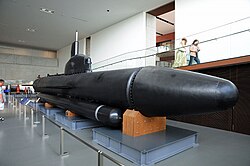Kairyū (submarine)
|
Longitudinal profile of the Kairyū
|
||||||||||||||
|
||||||||||||||
|
||||||||||||||
|
||||||||||||||
|
||||||||||||||
The Kairyū ( Japanese 海龍 , sea dragon ) was a series-produced class of small submarines of the Imperial Japanese Navy towards the end of the Pacific War .
Development history
The manufacture of the Kairyu began in February 1945 parallel to the construction of the Kōryū . At this point in time, the Japanese naval command had already converted the entire shipyard industry to the construction of small maritime weapons . The construction was made of three prefabricated parts and took two months. By September 1945, 760 boats were to be built. But massive air strikes on the shipyard impaired construction so much that only 213 boats had been completed by the end of the war. A further 201 were in final production in dry docks. Due to a lack of torpedoes towards the end of the war, an unknown number of Kairyu were provided with TNT explosive charges between 585 and 600 kg in the bow area, which were supposed to function as self-sacrifice boats. The boats were no longer used in war. The great importance of the Kairyu was underlined by the fact that from spring 1945 all material from canceled escort destroyers was assigned to it.
As far as is known, the following shipyards and companies were busy building the micro-submarine at the end of the war:
- Yokosuka naval shipyard : 30 boats under construction, 207 completed
- Hitachi shipyard, Kassado Iron Works: 2 boats under construction, 6 completed
- Mitsubishi shipyard in Yokohama : 35 boats under construction
- Kawaminami shipyard in Uranosaki : 10 boats under construction
- Uraga Sb shipyard: 50 boats under construction
- Hitachi shipyard in Sakurajima : 4 boats under construction
- Osaka Sb Co shipyard: 4 boats under construction
- Hitadi Innoshima shipyard in Habu : 5 boats under construction
- Hayashikane shipyard in Shimonoseki : 10 boats under construction
- Hakodate Docks shipyard: 41 boats under construction
- Fujinagata shipyard: 10 boats under construction
The cruising range was given as 450 nm at 5 kn when driving above water and 36 nm at 3 kn creeping under water. The armament consisted of two 45 cm torpedoes attached to the side of the hull of the boat or a 600 kg explosive charge in the bow. The diving depth was 145 meters without torpedoes and 100 m with torpedoes, as the compressive strength of the torpedoes limited the diving depth. The departure after an attack could therefore also take place deeper.
literature
- Harald Fock: Naval small weapons. Manned torpedoes, small submarines, small speedboats, explosives yesterday - today - tomorrow. Nikol, Hamburg 1996, ISBN 3-930656-34-5 , pp. 48-51.
